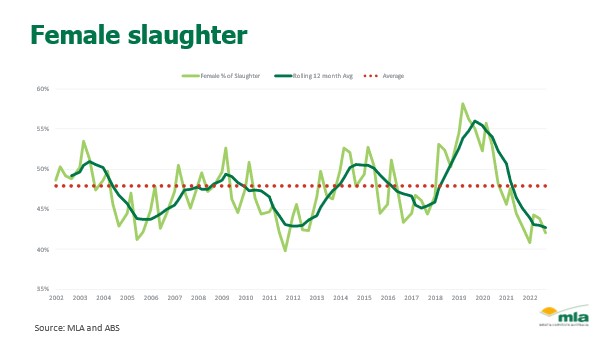Key points:
- In 2022, the female slaughter rate (FSR) hit its lowest level in 26 years.
- The decline in female kill numbers accounted for 86% of the total drop in Queensland slaughter numbers last year.
- The low FSR directly aligns with MLA's projection that the herd will grow to its highest level since 2014, as stated in the January Cattle projections.
On Thursday 16 February, the Australian Bureau of Statistics (ABS) released its Q4 production and slaughter data for 2022.
Following the data's release, MLA's Market Information team compiled an in-depth analysis of the key performance metrics for the cattle herd's rebuild, including the female slaughter rate (FSR).
The FSR is the total number of female cattle processed as a percentage of the total on a quarterly basis and is considered a key metric to the national herd rebuild/liquidation cycle.
In 2022, the national FSR averaged 42.8% – the lowest it has been since 1996 and the fifth lowest since ABS records began in 1976.
The low FSR directly aligns with MLA's Cattle projections, which forecast the herd to grow to its highest level since 2014. This figure recognises that 2022 was the most intense year of retention of females on-farm in 26 years – in fact, last year was within the top five strongest years for female retention in recorded history.
Figure 1. FSR rolling average lower than 2011–12 period


State breakdown
At a state level, NSW's FSR fell 3.4% year-on-year to average 40.4% while Queensland's FSR declined 2.9% to average 33.7%. In actual terms, female cattle kill rates accounted for 86% of the 157,000 head decline in Queensland kill numbers for the year.
As expected, the FSR in Victoria and WA remained elevated with larger numbers of dairy cows processed in these states. SA experienced the largest softening in kill numbers, falling 6.3% year-on-year. Overall, 213,000 less females were processed in 2022 compared with 2021.
Table 1. FSR 2021 vs 2022 at state level
NSW |
VIC |
QLD |
SA |
WA |
Australia |
|
2021 rate |
43.8% |
62.9% |
36.6% |
44.3% |
55.9% |
45.1% |
2022 rate |
40.4% |
61.6% |
33.7% |
38% |
54.8% |
42.8% |
% Change |
-3.4% |
-1.3% |
-2.9% |
-6.3% |
-1.1% |
-2.3% |
Actual change |
-36,177 |
-56,936 |
-136,115 |
-9,363 |
21,305 |
-212,879 |
In Q1 2023, another low quarter for the FSR can be expected – this will ensure the herd growth continues strongly. As the herd grows over the medium term, the FSR is likely to remain low due to larger calf drops and a larger supply of steers.
Looking ahead
Considering the historical lows of the FSR in 2022, this data supports MLA's Cattle projections and aligns with the supply improvements expected over the next few years.
Large calf drops, favourable branding rates and a genetically superior herd are all correlated to the outlook for a stronger cattle supply and the largest herd since the 1970s in 2025.






